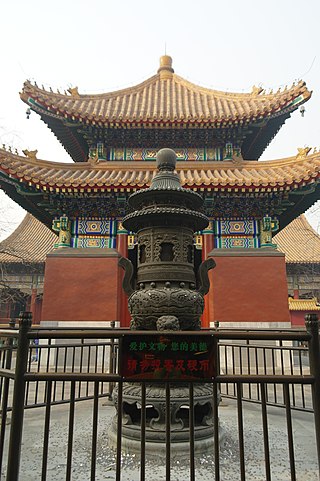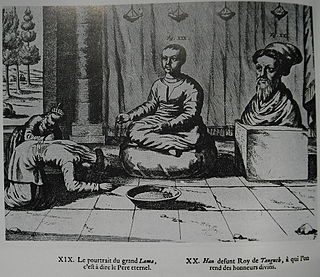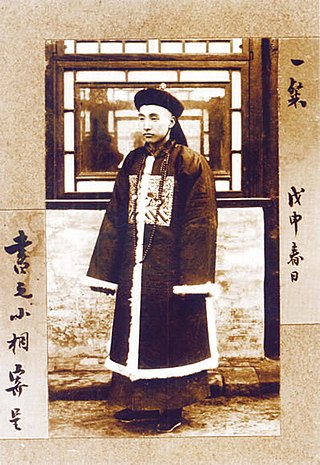
The Qing dynasty, officially the Great Qing, was a Manchu-led imperial dynasty of China (1636–1912) and the last imperial dynasty in Chinese history. It emerged from the Later Jin dynasty founded by the Jianzhou Jurchens, a Tungusic-speaking ethnic group who unified other Jurchen tribes to form a new "Manchu" ethnic identity. The dynasty was officially proclaimed in 1636 in Manchuria. It seized control of Beijing in 1644, then later expanded its rule over the whole of China proper and Taiwan, and finally expanded into Inner Asia. The dynasty lasted until 1912 when it was overthrown in the Xinhai Revolution. In Chinese historiography, the Qing dynasty was preceded by the Ming dynasty and succeeded by the Republic of China. The multiethnic Qing dynasty assembled the territorial base for modern China. It was the largest imperial dynasty in the history of China and in 1790 the fourth-largest empire in world history in terms of territorial size. With 419,264,000 citizens in 1907, it was the most populous country in the world at the time.

The People's Republic of China is officially an atheist state, but the government formally recognizes five religions: Buddhism, Taoism, Christianity, and Islam. In the early 21st century, there has been increasing official recognition of Confucianism and Chinese folk religion as part of China's cultural heritage. Chinese civilization has historically long been a cradle and host to a variety of the most enduring religio-philosophical traditions of the world. Confucianism and Taoism (Daoism), later joined by Buddhism, constitute the "three teachings" that have shaped Chinese culture. There are no clear boundaries between these intertwined religious systems, which do not claim to be exclusive, and elements of each enrich popular or folk religion. The emperors of China claimed the Mandate of Heaven and participated in Chinese religious practices. In the early 20th century, reform-minded officials and intellectuals attacked all religions as superstitious; since 1949, China has been governed by the CCP, a Marxist–Leninist atheist institution that prohibits party members from practicing religion while in office[citation needed]. In the culmination of a series of atheistic and anti-religious campaigns already underway since the late 19th century, the Cultural Revolution against old habits, ideas, customs, and culture, lasting from 1966 to 1976, destroyed or forced them underground. Under subsequent leaders, religious organisations have been given more autonomy.
The foreign relations of Imperial China from the Qin dynasty until the Qing dynasty encompassed many situations as the fortunes of dynasties rose and fell. Chinese culture had influenced neighboring and distant countries, while being transformed by outside influences as well as being conquered. During the Western Han dynasty, the Silk Road trade routes were established and brought Hellenistic Central Asia, Persia under the Parthian Empire, and South Asia into contact with the Chinese empire. During the 2nd century BC, Zhang Qian became the first known Chinese diplomat to venture deep into Central Asia in search of allies against the Mongolic Xiongnu confederation. Han Chinese attempts were made at reaching the Roman Empire and although the mission led by Gan Ying in 97 AD was a failure, Chinese historical records nevertheless maintain that the Romans traveled to southern China and Vietnam via the Indian Ocean. Buddhism from India was introduced to China during the Eastern Han period and would spread to neighboring Vietnam, Korea, and Japan, all of which would adopt similar Confucian cultures based on the Chinese model.

The Yonghe Temple, also known as the Yonghe Lamasery, or popularly as the Lama Temple, is a temple and monastery of the Gelug school of Tibetan Buddhism located on 12 Yonghegong Street, Dongcheng District, Beijing, China. The building and artwork of the temple is a combination of Han Chinese and Tibetan styles. This building is one of the largest Tibetan Buddhist monasteries in China proper. The current abbot is Lama Hu Xuefeng.

The Zongli Yamen, short for Office for the General Management of Affairs Concerning the Various Countries (总理各国事务衙门), also known as Prime Minister's Office, Office of General Management, was the government body in charge of foreign policy in imperial China during the late Qing dynasty. It was established by Prince Gong on 11 March 1861 after the Convention of Beijing. It was abolished by the Qing government in 1901 and replaced with a Foreign Office of ministry rank.
The Lifan Yuan was an agency in the government of the Qing dynasty of China which administered the empire's Inner Asian territories such as Mongolia and oversaw the appointments of Ambans in Tibet. Until the 1860s, it was also responsible for the Qing's relations with the Russian Empire.
State Religious Affairs Bureau Order No. 5, officially named Measures on the Management of the Reincarnation of Living Buddhas in Tibetan Buddhism, is an order passed during a conference of the State Administration for Religious Affairs on 13 July 2007, marked for implementation on 1 September 2007.

Mongolia under Qing rule was the rule of the Manchu-led Qing dynasty of China over the Mongolian Plateau, including the four Outer Mongolian aimags and the six Inner Mongolian aimags from the 17th century to the end of the dynasty. The term "Mongolia" is used here in the broader historical sense, and includes an area much larger than the modern-day state of Mongolia. Ligdan saw much of his power weakened due to the disunity of the Mongol tribes. He was subsequently defeated by the Later Jin dynasty and died soon afterwards. His son Ejei handed the Yuan imperial seal over to Hong Taiji in 1635, thus ending the rule of the Northern Yuan dynasty in Inner Mongolia. However, the Khalkha Mongols in Outer Mongolia continued to rule until they were overrun by the Dzungar Khanate in 1690, and they submitted to the Qing dynasty in 1691.
The Three Departments and Six Ministries system was the primary administrative structure in imperial China from the Sui dynasty (581–618) to the Yuan dynasty (1271–1368). It was also used by Balhae (698–926) and Goryeo (918–1392) and various other kingdoms in Manchuria, Korea and Vietnam.

The Ming dynasty considered Tibet to be part of Western Regions or "foreign barbarians". The exact nature of their relations is under dispute by modern scholars. Analysis of the relationship is further complicated by modern political conflicts and the application of Westphalian sovereignty to a time when the concept did not exist. The Historical Status of China's Tibet, a book published by the People's Republic of China, asserts that the Ming dynasty had unquestioned sovereignty over Tibet by pointing to the Ming court's issuing of various titles to Tibetan leaders, Tibetans' full acceptance of the titles, and a renewal process for successors of these titles that involved traveling to the Ming capital. Scholars in China also argue that Tibet has been an integral part of China since the 13th century and so it was a part of the Ming Empire. However, most scholars outside China, such as Turrell V. Wylie, Melvin C. Goldstein, and Helmut Hoffman, say that the relationship was one of suzerainty, Ming titles were only nominal, Tibet remained an independent region outside Ming control, and it simply paid tribute until the Jiajing Emperor, who ceased relations with Tibet.

The Kashag was the governing council of Tibet during the rule of the Qing dynasty and post-Qing period until the 1950s. It was created in 1721, and set by Qianlong Emperor in 1751 for the Ganden Phodrang in the 13-Article Ordinance for the More Effective Governing of Tibet. In that year the Tibetan government was reorganized after the riots in Lhasa of the previous year. The civil administration was represented by the Council (Kashag) after the post of Desi was abolished by the Qing imperial court. The Qing imperial court wanted the 7th Dalai Lama to hold both religious and administrative rule, while strengthening the position of the High Commissioners.
Shamanism was the dominant religion of the Jurchen people of northeast Asia and of their descendants, the Manchu people. As early as the Jin dynasty (1115–1234), the Jurchens conducted shamanic ceremonies at shrines called tangse. There were two kinds of shamans: those who entered in a trance and let themselves be possessed by the spirits, and those who conducted regular sacrifices to heaven, to a clan's ancestors, or to the clan's protective spirits.

Xu Jingcheng was a Chinese diplomat and Qing politician supportive of the Hundred Days' Reform. He was envoy to Belgium, France, Italy, Russia, Austria, the Netherlands, and Germany for the Qing imperial court and led reforms in modernizing China's railways and public works. As a modernizer and diplomat, he protested the breaches of international law in 1900 as one of the five ministers executed during the Boxer Rebellion. In Article IIa of the Boxer Protocol of 1901, the Eight-Nation Alliance that had provided military forces successfully pressed for the rehabilitation of Xu Jingcheng by an Imperial Edict of the Qing government:
Imperial Edict of the 13th February last rehabilitated the memories of Hsu Yung-yi, President of the Board of War; Li Shan, President of the Board of Works; Hsu Ching Cheng, Senior VicePresident of the Board of Civil Office; Lien Yuan, Vice-Chancellor of the Grand Council; and Yuan Chang, Vice-President of the Court of Sacrifices, who had been put to death for having protested against the outrageous breaches of international law of last year.

Chinese Esoteric Buddhism refers to traditions of Tantra and Esoteric Buddhism that have flourished among the Chinese people. The Tantric masters Śubhakarasiṃha, Vajrabodhi and Amoghavajra, established the Esoteric Buddhist Zhenyan tradition from 716 to 720 during the reign of Emperor Xuanzong of Tang. It employed mandalas, mantras, mudras, abhiṣekas, and deity yoga. The Zhenyan tradition was transported to Japan as Shingon Buddhism by Kūkai as well as influencing Korean Buddhism. The Song dynasty (960–1279) saw a second diffusion of Esoteric texts. Esoteric Buddhist practices continued to have an influence into the late imperial period and Tibetan Buddhism was also influential during the Yuan dynasty period and beyond. In the Ming dynasty (1368–1644) through to the modern period, esoteric practices and teachings became absorbed and merged with the other Chinese Buddhist traditions to a large extent.

Tibet under Qing rule refers to the Qing dynasty's relationship with Tibet from 1720 to 1912. The political status of Tibet during this period has been the subject of political debate. The Qing called Tibet a fanbang or fanshu, which has usually been translated as "vassal state." Chinese authorities referred to Tibet as a vassal state up until the 1950s and then as an "integral" part of China. The de facto independent Tibetan government (1912–1951) and Tibetan exiles promote the status of independent nation with only a "priest and patron" relationship between the Dalai Lama and the Qing emperor. Western historians such as Melvyn Goldstein, Elliot Sperling, and Jaques Gernet have described Tibet during the Qing period as a protectorate, vassal state, tributary, or something similar.

The priest and patron relationship, also written as priest-patron or cho-yon, is the Tibetan political theory that the relationship between Tibet and China referred to a symbiotic link between a spiritual leader and a lay patron, such as the historic relationship between the Dalai Lama and the Qing emperor. They were respectively spiritual teacher and lay patron rather than subject and lord. Chöyön is an abbreviation of two Tibetan words: chöney, "that which is worthy of being given gifts and alms", and yöndag, "he who gives gifts to that which is worthy".

The Bureau of Buddhist and Tibetan Affairs, or Xuanzheng Yuan was a government agency of the Mongol-led Yuan dynasty of China to handle Buddhist affairs across the empire in addition to managing the territory of Tibet. It was originally set up by Kublai Khan in 1264 under the name Zongzhi Yuan or the "Bureau of General Regulation", before it was renamed in 1288.
The Ministry of Ceremonies was one of the nine ministries of the Chinese Han dynasty. The Minister of Ceremonies, also known as Grand Master of Ceremonies, was the chief official in charge of religious rites, rituals, prayers, and the maintenance of ancestral temples and altars. The role's title was changed to Upholder of Ceremonies from 195 to 144 BC before reverting to the original title. Although his main concern was to link the emperor with the supernatural world and Heaven, he was also given the task of setting educational standards for the Imperial University and the academic chairs who specialized in the Five Classics, the canon of Confucianism.
The political systems of Imperial China can be divided into a state administrative body, provincial administrations, and a system for official selection. The three notable tendencies in the history of Chinese politics includes, the convergence of unity, the capital priority of absolute monarchy, and the standardization of official selection. Moreover, there were early supervisory systems that were originated by local factions, as well as other political systems worthy of mention.

The early Qing emperors adopted the bureaucratic structures and institutions from the preceding Ming dynasty but split rule between the Han and Manchus with some positions also given to Mongols. Like previous dynasties, the Qing recruited officials via the imperial examination system until the system was abolished in 1905. The Qing divided the positions into civil and military positions, each having nine grades or ranks, each subdivided into a and b categories. Civil appointments ranged from an attendant to the emperor or a Grand Secretary in the Forbidden City (highest) to being a prefectural tax collector, deputy jail warden, deputy police commissioner, or tax examiner. Military appointments ranged from being a field marshal or chamberlain of the imperial bodyguard to a third class sergeant, corporal or a first or second class private.











